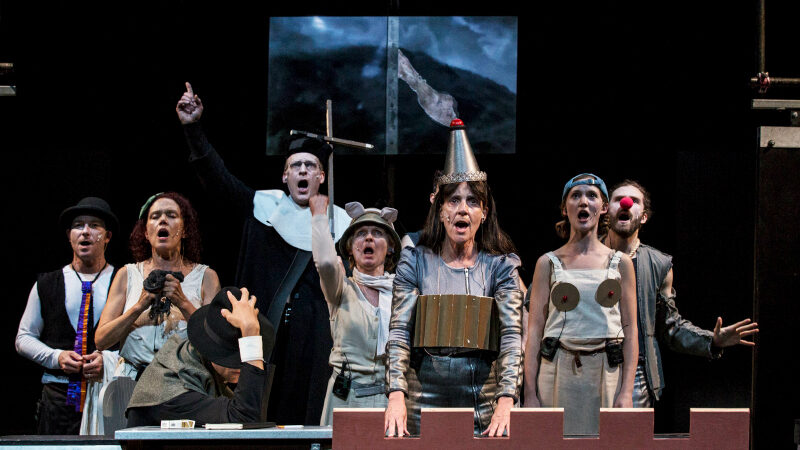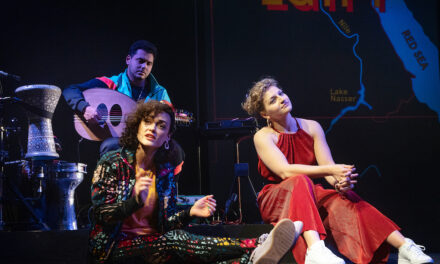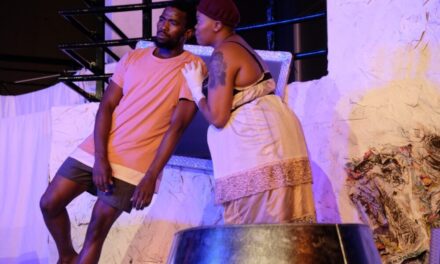Although he began his career as a painter, and worked as a professor at the Academy of Fine Arts in Kraków, Tadeusz Kantor (1915–90) is currently considered one of the most important theatre artists of the twentieth century, and, some argue, the most important Polish theatre director. His theories and aesthetics have influenced nearly all major figures of the modern avant-garde, including Reza Abdoh, Robert Wilson, Frank Castorf, Krystian Lupa, Richard Foreman, Moisés Kaufman, the Quay Brothers, and many others. Kantor’s work with happenings, bio-objects, and theatrical space provides a blueprint for the development of modern theatre and performance art.
Founded in 1955, throughout 35 years of experiments with actors, objects, and space, Kantor’s Cricot 2 Theatre would undergo a progressive transformation, from the Autonomous Theater (1956) through the Informel Theatre (1961), the Zero Theatre (1963), the Happening Theatre (1967), and the Impossible Theatre (1971–72), to the final period of the Theatre of Death (1975–90). Each stage in the development of the Cricot 2 Theatre would be announced in a manifesto written by Kantor to crystallize his newly evolved ideas. Tested and incorporated for a while, they would lead to new discoveries and to a new, evolved form of theatre.
While The Return of Odysseus is Kantor’s early pre–Cricot 2 work, I Shall Never Return belongs to the last, mature phase of his Theatre of Death (what many consider to be the essential Kantor). In many ways, I Shall Never Return is a collage of Kantor’s previous shows. Set in a bar with tables, the show alludes to many of Kantor’s regular characters: there is the Cleaning Woman (though as different persons, her character appears in almost all of his shows); there is the group of marching soldiers (who also appear in Wielopole, Wielopole, Let the Artists Die, and, later, in Today Is My Birthday); there is Kantor’s own mannequin getting married (his double, which also appears in the elusive Machine of Love and Death). The show doesn’t have a dramatic script, but the structure is somewhat comparable to Pirandello’s Six Characters in Search of an Author.
In Kantor’s I Shall Never Return, the actors rebel against their maestro by excavating for the public their deepest, most intimate fears, as though to refute his theory that it is impossible to do so. We witness the psychological disintegration of the actor’s self and the actors’ revolt against the process. The revolt also illustrates a conflict between the actors striving to preserve their own subjective existence and the author’s striving to convey his own subjective message. The actors arrive, quarrelsome and complaining, ‘looking for their author,’ without whom they can have no real existence even though they reject the forms of existence imposed on them. For the first time, the characters from Cricot 2 revolt against being directed into ‘one circus gesture’ and the unending conflict with the bio-objects forms assigned to them. They no longer wish to be hired only to display the ‘dark side’ of recollections that it is impossible to resurrect.
A Pink Chair is divided into a prologue and four parts. In the Prologue, Zbigniew Bzymek, who plays the young Kantor, reads from one of Kantor’s manifestos. The voice, which comes from the speaker, is that of a young man, which is a bit jarring, considering that most of Kantor’s recordings we have are of his old self.
Part I: Sugar High is a conversation with Tadeusz Kantor’s daughter, Dorota Krakowska. The audience watches a TV screen showing a video of Kate Valk and Dorota Krakowska discussing doing a documentary/theatre piece honoring/adapting/replicating Kantor and his work. They question whether it is even possible. The conversation is set in our reality and it is rooted in Aristotelian dramaturgy: we are faced with a challenge (characters’ motivation), and the question (whether they will succeed in achieving their goal). The question posed in this first part is the same question that implicitly is posed in Robert Wilson’s Einstein on the Beach, or Anne Bogart’s Bobrauschenbergamerica (and, in some ways, even in Gertrude Stein’s language portraits of Picasso and Matisse), that is, whether it is possible to create a ‘portrait’ of someone that is not a portrait, that is a work of theatre and language. In other words, what of the ‘essence’ of one’s personhood, particularly of one’s artistic personhood, that can be transferred to a theatrical medium?
From there, the show slowly, sneakily and brilliantly, transitions us into the postdramatic dramaturgy. In Part II: The Man in Place of Kantor, Dorota and Bzymek watch rehearsal footage of Kantor at work on I Shall Never Return. Like every rehearsal room, this is the liminal space between fiction and reality. In this part, we can clearly detect a tension between dramatic and postdramatic theatre, fighting for dominance of the theatrical space and their own rightful place. In Part III: A Miserable and Suspicious Inn, and in Part IV: Portrait of Dorota (“a testimony of things lost: a marriage ceremony, ending in a military parade”), we see a projection of a recording of I Shall Never Return (“the section where Kantor is confronted by his actors”), while the actors on stage replay the scenes with varying degrees of accuracy.
The scenes are illustrated by a number of songs, two of which deserve particular mention: the first is “Lulajże Jezuniu,” a Polish Catholic Christmas carol; considered by some to be the most beautiful of Polish carols, it is structured as a lullaby sung by Mary to baby Jesus. The second piece is a Jewish prayer song, “Ani Ma’amin” (“I believe”), often recited at morning prayers. The song closes the third part of the show, and by the time we get there, the entire spectacle has already transitioned to a postdramatic universe. The heart-wrenching melody inserts itself into this world of the play, reaching for the core of Kantor’s work.
Because at its very core, its very essence, Kantor’s work is by and about people traumatized: by the recent genocide that only a few of them survived; by the centuries of partitions, occupations, and pogroms; and, finally, by their current historical moment: years of Stalinist terror, and fear and loathing of the communist regime. It is difficult, if not impossible, to replicate that complexity of emotions without having lived the embodied experience. I never thought that American actors would be capable of such a feat. Yet, at the moment of “Ani Ma’amin,” the Wooster Group has accomplished what I always considered to be impossible: to embody that deep wound, the generational trauma that permeates the spirit (in Polish, “duch”) of Kantor’s work (and, in some ways, the Polish “duch”). For a brief moment, I got a sense that the actors are channeling their own lived trauma: New York City reeling after 9/11 . . . It’s been a long, long time since I was moved like this in a theatre. The show would be perfect if it ended on that note.
Unfortunately, where the show does not succeed is in its last section, Part V: The Return of Odysseus (an episode of the Odysseus story from I Shall Never Return). This section is staged as a kind of clown show, culminating in the rendition of “Bound for the Promised Land,” a Protestant hymn. The circus-like reference alludes to Kantor’s aesthetics, but it misses the mark. While attending the Cracow Academy of Fine Arts, in 1938, Kantor mounted his first production, a marionette version of Belgian symbolist Maurice Maeterlinck’s The Death of Tintagiles. The sketches for the production show circus aesthetics with colors resembling a clown show. Kantor’s theatre group, Cricot 2, is an anagram of “to circ,” which is not quite Polish for “it’s a circus” (the exact Polish would be “to cyrk”). These two facts and their timeframe are not insignificant.
Following World War II, Kantor no longer used circus aesthetics, or, rather, the clowns no longer looked like real clowns but rather like their ghosts, bedraggled and traumatized apparitions. The anagram is a further distortion, a flippage, the opposite of what a real circus is supposed to be (a mindlessly joyous place). There is a significant difference between the prewar sketches for the production of Maeterlinck’s play and the postwar designs for the 1961 production of Ionesco’s Rhinoceros at the Old Theatre, for example. While the sketches for The Death of Tintagiles are colorful and whimsical, the figures of Rhinoceros, though still somewhat grotesque and clownish, are in tatters, the survivors of the apocalypse. Staged during World War II, Wyspiański’s The Return of Odysseus showed no traces of the earlier circus aesthetics, leaning more towards the postwar approach. This is the primary reason that this particular section of the Wooster Group’s production does not succeed: Kantor’s production of Odysseus was no longer immersed in a circus as such. On the contrary, the aesthetic and premise of this production were very much rooted in the horrors of the surrounding war.
Wyspiański’s The Return of Odysseus was Kantor’s first truly avant-garde theatrical event; it was staged in 1942 during the German occupation of Poland, at the Cracow Underground Independent Theater. On the doors of the room where the play was being performed, Kantor placed the sign “You cannot enter the theater with impunity.” This statement, very real at the time since Germans persecuted anybody involved in any sort of cultural activity, would after the war become a metaphor for the emotional impact that Kantor’s plays had on his audience. In this simple production, Kantor made a first attempt at blurring the borders between fiction and reality, and hence at shaking the viewer’s sense of identity. Staging the play in a real house ruined by bombs allowed Kantor to relocate the audience from the fictional Ithaca it expected into the reality they sought to escape.
The main actor played both Odysseus and himself, a man returning from the war, a fact of which the audience became aware only as the play progressed. Describing the opening scene in the partiture to the spectacle, Kantor wrote: “Wearing a muddy uniform and a helmet, Odysseus passes through the audience; very long triumphant sounds of a parade march are heard; Odysseus sits heavily on a gun-barrel, hunched over, forming a shapeless mass; it is unclear what he is . . .” After a while, the audience becomes disoriented, convinced that the actor is a mad soldier who has wandered on to the stage and who is disrupting the production. Finally, “an actor who plays the Shepherd begins talking to Odysseus [in order to move him off the stage]. Suddenly, the spectators notice Odysseus’ violent gesture and a club hitting the Shepherd’s head . . .” The Shepherd falls down dead, and Odysseus begins his first line: “I am Odysseus, returning from Ithaca . . .”
Setting the play within the reality of the German occupation had a nearly terrorizing effect as the audience realized that the rugged soldier was an actual actor. As a real soldier, he was so much a part of the surrounding reality that his condition became a function of this reality, and, hence, its familiarity made it invisible. It was at the moment when the reality was turning into fiction and vice versa, when his tragedy grew discernible, that it gained the power to shock and transform. The drama taking place on the stage not only paralleled or illustrated the one taking place in reality; it also had to happen in reality. In his notebook from 1944, Kantor wrote: “Odysseus must return for real. It would be hypocritical to try to create the fake illusion of Ithaca.”
In Kantor’s productions, the actors, like Odysseus, perpetually oscillate between fiction and reality; they are neither themselves nor the characters they play. Knowing no longer to which domain – fictional or real – the character belongs, the audience cannot dismiss it as it would if its fate were either completely fictional or completely real. The spectator can no longer remain a passive recipient of someone else’s pain; there is no catharsis here, no release. Unfortunately, we have no recording of that first production, and the only documentation is Kantor’s notes and one black-and-white photo of the soldier/Odysseus.
The figure of Odysseus would return again and again in Kantor’s other works as a kind of symbol of the artist wanderer (and of the wandering Jew – an image deeply embedded in the Polish psyche since its own diaspora of the Romantic era.) In fact, Kantor would eventually assemble the entire collection of “Eternal Wanderers,” an array of figures carrying “parcels, bags, suitcases, rucksacks.” They symbolized European Jews disposed of and shipped to concentration camps, carrying their most precious belongings with them. Since the meaning of the figure of Odysseus is so multilayered, the clownish rendition of the scene from Kantor’s work, in A Pink Chair, does not achieve the same intensity as the previous scenes, and by the time we get to the final image with “Bound for the Promised Land,” the scene – with its circus-like aesthetics and feel – feels somewhat deflated and misplaced. Given the current refugee crisis, the potential for restaging of The Return of Odysseus as relevant to our present moment is endless, and the company seems to have missed this opportunity. If the scene were moved to somewhere in the middle of the show, leaving “Ani Ma’amin” for the ending, it would have made the production more internally coherent with the progression from dramatic to postdramatic theatrical universe longer and, hence, even more surprising and delightful. The lack of engagement with both the crux of Wyspiański’s The Return of Odysseus and Kantor’s version of it might be, in fact, the weakest point of the Wooster Group’s show.
Of course, the main question that everyone familiar with both Kantor’s work and the Wooster Group’s work is whether Kantor would have approved of the production. Probably not, and not just because knowing his own artistic megalomania, he would feel it’s somewhat sacrilegious to try to ‘capture’ or imitate his person and style. He would be baffled by the aesthetics of The Return of Odysseus, which he would most likely consider misplaced, and by LeCompte’s claim to his legacy. Nonetheless, A Pink Chair is an accomplishment, and probably one of the best shows of this season. And the answer is no, you can never return to your Ithaca . . .
[This review was updated on July 18, 2018]
This post was written by the author in their personal capacity.The opinions expressed in this article are the author’s own and do not reflect the view of The Theatre Times, their staff or collaborators.
This post was written by Magda Romanska.
The views expressed here belong to the author and do not necessarily reflect our views and opinions.


















